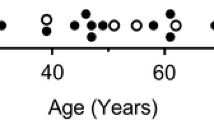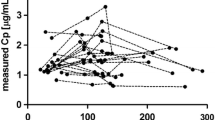Summary
The pharmacokinetic behaviour of alcuronium is described for nineteen patients undergoing anaesthesia for elective surgery. Eleven patients received a single bolus intravenous dose of 0.25 mg/kg, while 8 patients required additional doses of 0.125 mg/kg. A two-compartment open model was found to describe adequately both the single dose and multiple dose data for the majority of patients. No significant differences were found in the model-independent pharmacokinetic parameters between the single and multiple dose studies. Mean values for the pooled data for the half-life (t1/2β), apparent volume of distribution (Vdβ), volume of distribution at steady-state (Vdss), volume of the central compartment (Vc) and plasma clearance (Clp) were 198.75 min, 24.261, 20.891, 8.181 and 90.22 ml/min respectively. Evoked muscle twitch response was monitored in 17 of the patients to assess the degree of relaxant blockade. The bolus dose of alcuronium produced complete block in 9 patients and between 95 and 99% block in the remainder. The time of onset to maximum block ranged from 3 to 30 min with the concurrently measured plasma levels of alcuronium being 0.79 to 2.25 µg/ml. The time taken following bolus administration to 5% recovery (95% paralysis) was a mean of 42 min and the corresponding mean alcuronium plasma concentration was 0.78 µg/ml.
Similar content being viewed by others
References
Agoston S, Vermeer GA, Kersten UW, Meijer DKF (1973) The fate of pancuronium bromide in man. Acta Anaesth Scand 17: 267–275
Ali HH, Savarese JJ (1976) Monitoring of neuromuscular transmission. Anesthesiology 45: 216–249
Barth L, Dannhorn R (1977) Prolonged neuromuscular activity of non-depolarising muscle relaxants, investigated by tetanic resistance. Anaesthesist 26: 116–124
Boxenbaum HG, Riegelman S, Elashoff RM (1974) Statistical estimations in pharmacokinetics. J Pharmacokin Biopharm 2: 123–148
Buzello W (1975) Der Stoffwechsel von Pancuronium beim Menschen. Anaesthesist 24: 13–18
Buzello W, Agoston S (1978) Comparative clinical pharmacokinetics of d-tubocurarine, gallamine, alcuronium and pancuronium. Anaesthesist 27: 313–318
Dwyer BE, Gunner BW, Walker WD (1967) Diallyl-nortoxiferine (“Alloferin”). A clinical appraisal. Aust N Z J Surg 37: 54–57
Goldstein A (1964) Biostatistics: an introductory text. Macmillan, New York, p 51
Hügin W, Kissling P (1961) Vorläufige Mitteilungen über ein neues kurzwirkendes Relaxans vom depolarisationshindernden Typus, das RO4-3816. Schweiz Med Wochenschr 91: 455–457
Hügin W (1972) Muscle relaxants in surgery and the new compound ‘Alloferin’ Roche. In: Alloferin, medium-long-acting muscle relaxant of the non-depolarising type. F. Hoffman — La Roche and Co. Ltd. Basle, Switzerland
Katz RL, Katz GJ (1975) In: Katz RL (ed) Muscle relaxants. Excerpta Medica, Amsterdam pp 313–334
Kersten UW, Meijer DKF, Agoston S (1973) Fluorimetric and chromotographic determination of pancuronium bromide and its metabolites in biological materials. Clin Chim Acta 44: 59–66
Pederson PVL (1977) Curve fitting and modelling in pharmacokinetics and some practical experiences with NONLIN and a new program FUNFIT. J Pharmacokin Biopharm 5: 513–531
Raaflaub J, Frey P (1972) Zur Pharmacokinetik von diallyl-nor-toxiferin beim Menschen. Arzneim Forsch 22: 73–78
Ramzan MI, Triggs EJ, Shanks CA (1980) Pharmacokinetic studies in man with gallamine triethiodide I. Single and Multiple Clinical doses. Eur J Clin Pharmacol 17: 135–143
Shanks CA, Ramzan MI, Triggs EJ (1979) Studies in man with a constant-rate infusion of tubocurarine. Anaesth Intensive Care 7: 209–214
Sheiner LB, Stanski DR (1979) Pharmacokinetics and dynamics of muscle relaxants. Anesthesiology 51: 103–105
Somogyi AA, Shanks CA, Triggs EJ (1976) Clinical pharmacokinetics of pancuronium bromide. Eur J Clin Pharmacol 10: 367–372
Thomas J, Climie CR, Mather LE (1969) Placental transfer of alcuronium. Br J Anaesth 41: 297–301
Wagner JG (1976) Linear pharmacokinetic equations allowing direct calculation of many needed pharmacokinetic parameters from the coefficients and exponents of polyexponential equations which have been fitted to the data. J Pharmacokinet Biopharm 4: 443–467
Walts LF, Dillon JB (1968) Durations of action of d-tubocurarine and gallamine. Anesthesiology 29: 499–504
Author information
Authors and Affiliations
Rights and permissions
About this article
Cite this article
Walker, J., Shanks, C.A. & Triggs, E.J. Clinical pharmacokinetics of alcuronium chloride in man. Eur J Clin Pharmacol 17, 449–457 (1980). https://doi.org/10.1007/BF00570163
Received:
Accepted:
Issue Date:
DOI: https://doi.org/10.1007/BF00570163




